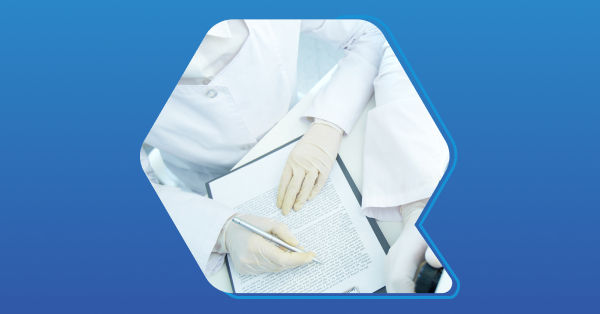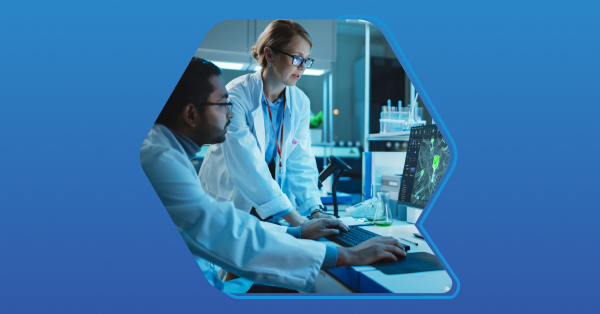How a LIMS Improves Data Traceability for Labs

How confident are you in your lab’s data?
Being able to trust your data and results is critical to labs across most industries. It’s especially important if your lab wants to meet ISO 17025 standards to demonstrate the reliability of your data.
A key piece of ensuring you can trust your data is data traceability. It’s not just about keeping good records, it’s a matter of ensuring the integrity, reliability, and accountability of every single data point.
Doing that manually or in spreadsheets? It can quickly turn into many hours of busy work and upkeep for your lab. Fortunately, there is a solution available to modern labs: a LIMS. A LIMS is a game-changer for laboratories looking to streamline their operations and improve efficiency.
Read on as we reveal how a LIMS can revolutionize your lab's data management.
Why Data Traceability Matters
Imagine this: you’ve just been asked to provide documentation for a sample that was tested months ago.
How are you feeling?
Without proper data traceability, you might find yourself drowning in a sea of paperwork. But with a LIMS, you can breathe easy knowing that every step of the sample's journey has been meticulously recorded and is just a few clicks away.
Data traceability isn’t a “nice-to-have” for labs, it’s a necessity. Data traceability is the backbone of your lab’s scientific integrity, reliability, and trust. Without it, your lab risks losing credibility, facing legal consequences, and damaging its reputation.
Not only that, but poor data management can lead to:
- Improper conclusions being drawn
- Lost customer data or records
- Breakdowns in trust with your customers
- Wasted time and paperwork
- Failure to meet compliance standards
But with a LIMS, you can rest assured that your data is always accurate, accessible, and audit-ready.
How a LIMS Helps Ensure Data Traceability
A LIMS can help with data traceability through data capture and automation.
Thanks to a LIMS, your lab can wave goodbye to the days of manual data entry and scattered records. Every sample, test, and result is automatically logged and timestamped in a centralized database.
This means no more hunting for missing files (or deciphering illegible handwriting).
But a LIMS doesn't just store data; it also tracks and manages every step of the sample's journey, from receipt to disposal. This creates a complete audit trail that can be easily accessed and reviewed at any time.
Practical Example:
Imagine receiving a sample for a critical test. With a LIMS, you can scan the barcode when the sample arrives, instantly logging it into the system. As the sample moves through different testing stages, each step is recorded automatically. If a question arises about the sample’s history, you can quickly pull up its entire journey in the LIMS, ensuring no data is lost or misplaced.
This is one (of many) ways that a LIMS is far superior to managing your lab’s data with pen and paper or spreadsheets. While doing things the “old-fashioned way” may have a degree of charm or comfort, there is no denying that a lack of automation and data centralization will hold your lab back. Not only do manual data entry methods take more time, they also put you at risk of human error, data loss, damage to your records, and unauthorized access.
A LIMS on the other hand acts as part GPS and part control center for your lab.
You can:
- Track every sample from the moment it enters your lab to the minute it’s ready to be disposed of.
- Integrate instruments to ensure accurate data transcription
- Scan barcodes
- Report on test stages–you can know the location, status, and chain of custody for every sample in your lab
- Automate steps of your workflow
- Regularly back up data and restore it if needed
Practical Tip:
Set up your LIMS to automatically generate alerts for critical steps in the sample lifecycle, such as when a sample is due for disposal or when a test result is ready for review. This proactive approach ensures no important tasks are overlooked.
Can your Excel spreadsheet do that?

Benefits of Using a LIMS for Data Traceability and Integrity
We just scratched the surface in the previous section, here are our five favorite benefits of using a LIMS to improve data traceability and data integrity:
- Increased efficiency and productivity: A LIMS is a godsend when it comes to boosting your lab’s efficiency. Thanks to time-saving automations and the digitization of records, your staff can reduce their manual work and focus more on the task at hand. Example: Automate routine tasks such as sample logging and test scheduling, freeing up staff to focus on analysis and research.
- Reduced errors and rework: Less manual data entry means fewer opportunities for errors that will compromise your data and slow your lab down. Example: Use barcode scanning to minimize manual data entry errors and ensure accurate data capture.
- Improved regulatory compliance and audit readiness: A LIMS is invaluable in helping your lab prepare for an audit or inspection thanks to the many features that streamline your operations and ensure the integrity of your data. Example: Maintain detailed audit trails and electronic signatures to meet ISO 17025 requirements effortlessly.
- Enhanced collaboration and data sharing: While spreadsheets may be free or low cost, they can’t easily be shared - especially for distributed teams. A cloud-based LIMS makes your lab’s data accessible to your entire staff, no matter where they are based. Example: Remotely access the LIMS to sign off on draft reports.
- Better decision-making and insights through data analytics: On-the-fly reports and custom dashboards make it easy for your lab to get impactful insights from your data and make better decisions. Example: Generate real-time reports on sample turnaround times to identify bottlenecks and improve workflow efficiency.
Clearly a LIMS is a major asset for labs looking to improve data management. Read on as we highlight the key features to look for in a LIMS.
Top Features of a LIMS for Data Traceability
While many LIMS platforms will offer a similar suite of features, no two are the same (check out our breakdown of the best LIMS on the market).
When considering a LIMS with data traceability in mind, we recommend looking for one with the following features:
- Sample tracking: This is the core of any LIMS, the ability to manage and track samples throughout their lifecycle in your lab. QBench LIMS boasts powerful sample management features that help labs manage samples at scale.
- Audit trails and electronic signatures: Look for a LIMS with robust security features to ensure the integrity of your lab’s data. QBench boasts audit trails, role-based access, and data backups to protect your data. In case of a breach or technical failure, you can know exactly what happened to your lab’s data and restore it if needed.
- Configurable workflows: Look for a LIMS with robust yet easy-to-use configuration and automation features. Many LIMS offer customization, but only via writing custom codeble workflows that requires development resources to set up and modify. QBench supports configurable no-code automation features to streamline and automate your lab workflows without engineering support.
- Instrument integration and data capture: From lab instruments to software, there are many ways your lab collects and interacts with data. QBench LIMS supports over 50 integrations and a RESTful API allowing you to bring all of your lab’s data under one roof. Thanks to features like barcode scanning, you can reduce entry errors and ensure your data is captured cleanly and correctly.
- Reporting and data analytics: Look for a LIMS with robust reporting features to generate reports on the fly or build dashboards for an overview of your lab’s data.
By selecting a LIMS with these features you set your lab up for success.
Ready to Improve Your Lab’s Data? Make Sure You Choose the Right LIMS
By automating and centralizing your lab's data management, a LIMS can help you ensure the highest levels of traceability, integrity, and efficiency. It's not just a tool; it's a strategic investment in your lab's future.
So if you're ready to take your lab's data management to the next level, it's time to consider a LIMS. With the right solution and partner, you can transform your lab into a traceability powerhouse and set yourself up for success in the ever-evolving world of science and technology.
Download our free guide to choosing the right LIMS for your lab.








